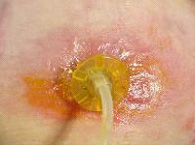Tube issues
Blocked tube
Causes:
Poorly crushed medications
Not flushing gastrostomy tube when feeds are completed
Feed too thick or containing lumps of powder
Vitamised food being put down tube
Leaving formula in the tube to curdle
To unblock the gastrostomy tube, flush it with 10 - 20 mL of a
carbonated drink such as mineral water or diet cola.
Sometimes the blockage can be aspirated out using a syringe.
Peri-stomal issues
Leakage around the tube
Related to the relative sizes of the tube and stomal
tract. If the tube is too small for the opening, it may need
replacement with a larger tube.
Other possible causes include:
Deflated or ruptured balloon.
This can be checked by attempting to drain the balloon. If
there is no fluid the balloon may be deflated or have burst.
Injecting water into the balloon and then checking if the volume is
the same when draining will indicate if there has been a rupture.
If the balloon has burst the tube will need replacing. The only
sure way to tell is to remove the tube.
Tube deterioration or damage
Tube may need replacement.
Tube Migration
The tube may have migrated down the stomach and the balloon is not
flush with the gastric mucosa. Putting gentle traction on the tube
and then adjusting the retention disc to fit snugly against the
abdominal wall may help.
Skin excoriation
Gastric secretions leaking around the gastrostomy can result in
skin excoriation. There are two methods of minimising irritation to
the skin:
Use of a barrier ointment (better than cream)
Recommended products include Calmoseptine™ ointment, Ilex™
barrier ointment, or a zinc ointment.
If the site is affected by thrush, do NOT use a zinc based
product as this may worsen the infection. Suitable
alternatives include Orabase™ or Coloplast™ paste.
Medications to halt gastric acid production.
Red, irritated, swollen, oozing skin surrounding a gastrostomy
can be treated with:
A foam dressing, gauze or Sofwick to absorb excess ooze
Topical Magnesium + aluminium hydroxide preparations (eg
Mylanta)
Hydrocolloid powder to aid in stopping bleeding and absorb
excess moisture
A thin hydrocolloid dressing (eg Duoderm wafer) to protect and
aid in healing of excoriated skin
Granulation tissue
Granulation tissue usually occurs about 6 weeks post
surgery. It may be caused by the tube moving too
freely. If this is the case an anchor device eg FlexiTrak can
be useful.
Options to treat granulation tissue:
A foam dressing to apply pressure to reduce granulation.
Silver nitrate application daily (to granulation tissue
only)
Application of a steroid cream
Infections
 Candida; under the
skin flange, use topical antifungal preparations eg clotrimazole or
nystatin.
Candida; under the
skin flange, use topical antifungal preparations eg clotrimazole or
nystatin.
Cellulitis (see photo); is normally due to
staphylococcal infection (but can involve enteric flora) and
appropriate antibiotics should be given eg oral or intravenous
flucloxacillin. If the site is very swollen, the tube may
have to be removed to relieve pain. If there is discharge
from the site, a skin/wound swab should be sent for microscopy and
culture prior to commencing treatment.